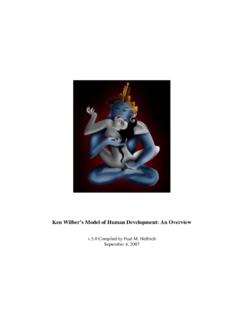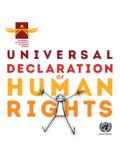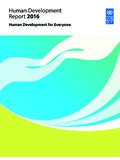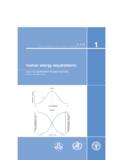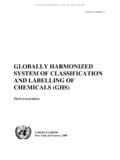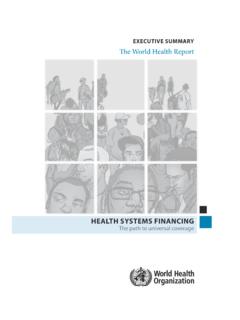Transcription of Mining Community Development Agreements
1 Mining Community Development Agreements Source Book March 2012. THE WORLD BANK. i 5/24/12 9:33 AM. ii 5/24/12 9:33 AM. Contents ACKNOWLEDGMENT ..vii foreword ..ix 1. INTRODUCTION ..1. Objectives of This Document .. 3. TARGET AUDIENCE .. 3. 2. WHAT IS A CDA? ..5. CDA 6. When and Why Should CDAs Be Developed? .. 9. What Is a Successful CDA? .. 10. Participatory Approach .. 14. CDA Process .. 14. Timeframe and Process .. 15. 3. PHASE 1: STAKEHOLDER IDENTIFICATION, ANALYSIS AND ENGAGEMENT ..18. Qualified Communities .. 18. Stakeholder Mapping and Analysis .. 22. The Roles and Responsibilities of Stakeholders .. 24. GOVERNMENT .. 26. Mining COMPANIES .. 27. THIRD PARTIES .. 27. VARYING RESPONSIBILITIES .. 28. Engagement Planning .. 29. Phase 1 30. 4. PHASE 2: CAPACITY Development FOR A CDA ..31. Capacity Assessment .. 32. TYPES OF CAPACITY .. 32. PARTICIPATORY NEEDS ASSESSMENT .. 34. Capacity Development .. 36. Partner Organizations .. 40. Phase 2 41. 5. PHASE 3: STAKEHOLDER Community Representation.
2 42. RISKS OF INEQUALITY AND INEQUITY .. 43. THE CRITICAL ROLE OF PARTNERSHIPS AND MULTI-STAKEHOLDER FORUMS .. 43. Representation of Government, Industry, and Third 44. Phase 3 45. iii iii 5/24/12 2:05 PM. 6. PHASE 4: IMPLEMENTATION ISSUES AND FEEDBACK MECHANISMS. FOR A CDA ..46. Potential to Withdraw Clauses .. 46. Confidentiality .. 48. Grievance, Feedback, and Dispute Resolution Mechanisms .. 48. GENERAL PRINCIPLES .. 48. INTEGRATION WITH 50. Community /Social Investment .. 51. GENERAL PRINCIPLES .. 51. Phase 4 54. 7. MANAGEMENT, BUDGETING, MONITORING, ASSESSMENT, AND SUSTAINABILITY ..55. CDAs and Budgeting .. 56. DESIGN PRINCIPLES .. 56. SUSTAINABLE BUDGETING .. 57. Monitoring and Evaluation .. 57. Accountability and Transparency .. 58. CDA and Local Economic Development 59. CDAs and Closure Planning .. 60. CDAS, CLOSURE, AND LOCAL Development PLANS .. 60. CDAS, CLOSURE, AND CAPACITY Development .. 60. CDAS AND FUTURE FUNDING .. 61. CDAs and Project 61. REFERENCES ..62. Summary of Figures Figure Core Principles for CDA Development .
3 10. Figure Flow Chart: Example CDA Development Process .. 15. Figure CDA Processes over the Mine Life .. 17. Figure Basic Stakeholder Mapping Concept .. 22. Figure Example Stakeholder Map .. 23. Figure Basic Feedback Mechanism .. 49. Figure Planning for Community /Social Investment .. 52. Summary of Tables Table Benefits of Community Development Agreements .. 8. Table Building Blocks of Community Development Agreements .. 11. Table Summary of Recommended CDA Outputs .. 16. Table Information Sources for the Determination for Qualified Communities .. 21. Table Capacity Requirements and Questions .. 35. Table Examples of Capacity Development Methods .. 37. iv iv 5/24/12 2:05 PM. List of Acronyms BTC Baku-Tblisi-Ceyhan CDA Community Development Agreements CDRF Capacity Development Results Framework CMCAs Community Mine Continuation Agreements CSR Corporate Social Responsibility CSRM Centre for Social Responsibility in Mining ERM Emvironmental Resources Management ESHIAs Environmental, Social, and Health Impact Assessments FTFs Foundations, Trusts, and Funds IBAs Impact Benefit Agreements ICMM International Council on Mining & Metals IFC International Finance Corporation ILUA Indigenous Land Use agreement NADeF Newmont Ahafo Development Foundation NGOs Nongovernmental organizations O&G Oil and Gas PNG Papua New Guinea SAFETE South African Fund for African Energy, Transport, and Extractive Industries UNDP United Nations Development Program WBG World Bank Group v v 5/24/12 9:33 AM.
4 Vi 5/24/12 9:33 AM. Acknowledgment This report Mining Community Development agreement Source Book is a product of the World Bank Sustainable Energy Oil, Gas, and Mining Unit (SEGOM). The task team comprised of Boubacar Bocoum (Task Team Leader), Kristina Svensson (Operations Offi- cer), Peter van der Veen (consultant), Charles E. Di Leva (Chief Counsel, LEGEN), and Sachiko Morita (Counsel, LEGEN). The World Bank task team would like to acknowledge the contributions of James Otto, the Environmental Resources Management (ERM), and the University of Queensland CDA. who were the primary authors of the documents synthesised by ERM, and complemented where relevant by the later to form the core of this report. The World Bank task team would also like to thank Paulo de Sa, Sector Manager (SEGOM), Marianne Fay (Chief Economist SDN) and many colleagues from SEGOM and the World Bank Group for their valuable support and contribution to this work. The World Bank task team would like to also recognise the contribution of Mining com- panies, governments, and civil society organizations in Argentina, Canada, Ghana, Kyrgyzstan Republic, Liberia, Papua New Guinea, Lao PDR, Nigeria, USA and elsewhere for their participation in the case studies and consultations.
5 The report benefited from written comments received from peer reviewers Harvey Van Veldhuizen (OPCQC), Dafna Tapiero (COCSC), Christopher Gilbert Sheldon (SEGOM), Mohammed Bekhechi (LEGEN), Deval Desai (LEGJR), and from Luc Danielson (Sus- tainable Develepment Strategies Group) in his capacity as an external reviewer. It also benefited from contributions from Marietta Shimizu-Larenas (consultant), Gary McMahon (SEGOM), John Butler (EAPCO), Victoria Bruce-Goga (SEGOM), and Raja Manikandan (SEGOM). The World Bank would also like to thank the South African Fund for African Energy, Trans- port, and Extractive Industries (SAFETE) for financing this work. vii vii 5/24/12 9:33 AM. viii 5/24/12 9:33 AM. foreword Recently, there has been a growing interest by government policymakers, civil society, communities, and Mining companies on the sustained Development of mine-impacted communities as part of the debate around the costs and benefits of mineral Development . Communities have become more vocal in expressing their expectations for benefits, while Mining companies are concerned about the need and means by which to obtain and main- tain their social license to operate based on local Community support.
6 The World Bank Group (WBG) in cooperation and consultation with other stakeholders has been involved in developing practical approaches that can be adopted by industry, government, and other stakeholders. Examples of this involvement include, but are not limited to, the Equator Principles (lending principles) and a Community Development Toolkit (jointly devel- oped and published by the World Bank Group and the International Council on Mining and Metals). Various other instruments have addressed the challenge of increasing local Community benefits. Community Development Agreements (CDA) between companies and impacted communities, for example, have played a valuable role in meeting the expectations and needs of a broad range of stakeholders. They are increasingly considered a key instrument for defining the relationship and obligations of Mining companies with impacted commu- nities, including the roles of local and national governments and nongovernmental orga- nizations. However, the absence of a common framework has led to a number of different approaches to CDAs that have had varying outcomes.
7 Given the current status of CDAs, there is a need to extract from current practice the key building blocks for successful Community Development . To address this need the World Bank's Oil, Gas and Mining Unit launched a project to review and analyze the global expe- rience in Community Development Agreements (voluntary or regulated) with the objective to develop a methodology through which the approach to Mining Community Development could be improved and the results measured on the ground. A consulting firm, Jim Otto (sole proprietor) was commissioned to carry out the assign- ment. The work on the framework for CDAs was phased, starting with a desktop identifi- cation from current practices of the key building blocks to enable appreciable Community Development . The result of this was the Development of draft model CDA regulations. The next phase consisted of a number of internal and external consultations with a broad spectrum of stakeholders (governments, private sector, and civil society organizations).
8 The feedback informed the updating of the draft model CDA regulations and the drafting of guidelines for CDAs. The consultations also indicated that further research and defini- tion of the process and some of the building blocks of a CDA could enhance its usefulness and effectiveness. This led to the commissioning of two additional pieces of work, a field research assignment by ERM to assess the Community Development practice in three dif- ferent countries (Argentina, Ghana, and Papua New Guinea) on three continents (Africa, America, and Asia) and to test the robustness of the building blocks identified. In addition ix ix 5/24/12 9:33 AM. the University of Queensland was approached to conduct additional research to formulate Good Practice Notes on the processes and frameworks used to negotiate, structure, and implement CDAs in order to maximize the Development outcomes. This publication presents the results of the analytical work and research conducted by these groups. It is hoped that this Source Book will not only make a contribution to the under- standing of Mining and Community issues but will also have a measurable impact on the ground as an applicable tool.
9 This publication is not intended to be prescriptive, as the devel- opment of any CDA should consider the local context, including the applicable regulatory structure(s) specific Community /stakeholder interests, values, concerns, and capacity. Since this project and report were prepared as a discussion paper, we would like to thank the participants government officials, civil society, and private sector representatives in the various workshops and other consultations for their input, while at the same time we wel- come further feedback and comments. x x 5/24/12 9:33 AM. 1. Introduction The World Bank Oil, Gas and Mining Unit, in its capacity as a driver for best practice related to extractive industry contributions to poverty alleviation, has a strong interest in the sustainable Development of mine-impacted communities. As part of the growing global expectation that the extractive industry should contribute positively to long-term local Development , a discourse has grown surrounding a variety of structures and processes aim- ing to deliver Development benefits to communities affected by mineral resource projects.
10 Examples of these strategies include social/ Community investment programs, Development forums, Community -controlled trusts, Development funds, and foundations. These strate- gies may be led by government, the companies, the impacted Community , or through col- laborative bilateral or multisector partnerships and Agreements . They may be a regulatory requirement or negotiated voluntarily in response to Mining companies' commitment to corporate social responsibility (CSR) principles. This document describes some of the main considerations and processes regarding the Development and implementation of these strategies, specifically in relation to Community Development Agreements (CDAs). In the last few years the World Bank Oil, Gas and Mining Unit has worked to analyze CDAs within the Mining sector as an instrument for more sustainable and equitable benefits. This includes using CDAs as a tool to enhance Community participation and consultation, manage expectations of involved parties, and ultimately maximize pro-poor benefits to impacted communities while helping to establish social license to operate for govern- ments and industry.











